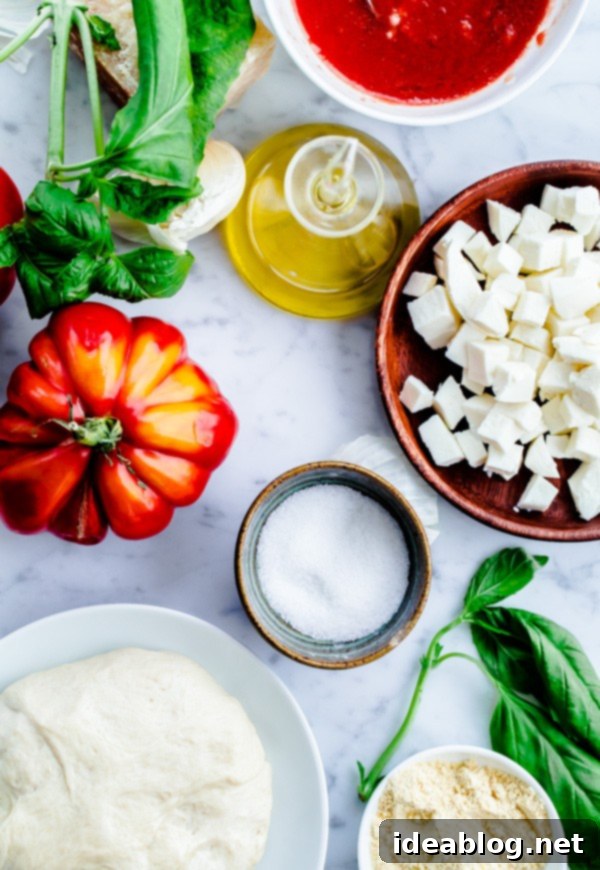Mastering the Best Homemade Margherita Pizza: An Authentic Recipe for Your Standard Oven
After countless experiments and a relentless pursuit, my quest for the ultimate homemade margherita pizza is officially complete! This exceptional recipe, designed specifically for standard kitchen ovens and using readily available ingredients, delivers a truly remarkable result. You’ll find yourself reaching for this classic Italian pizza recipe again and again. For comprehensive, step-by-step instructions on crafting the perfect pizza dough, be sure to watch our detailed margherita pizzavideo!

The moment has finally arrived! I know I’ve been hinting at this on Instagram for weeks, and for that, I offer my sincerest apologies. My excuse? I was simply too engrossed in thoroughly enjoying every single slice of this incredible margherita pizza.
Let me be completely candid with you. It is exceedingly rare for me to declare any recipe as the “best” of anything, let alone to emphasize it with capital letters. While I frequently share dishes I find utterly delicious, making such bold, definitive statements generally makes me quite uncomfortable. My greatest fear is that you, my valued reader, will invest your time and effort into preparing a recipe I’ve touted as the ultimate, only to be met with disappointment. That would truly upset me.
However, I feel an undeniable surge of confidence about this particular homemade margherita pizza recipe. I genuinely believe it stands head and shoulders above other home-cooked versions, and I am absolutely convinced that you will adore it just as much as I do.

While I wouldn’t consider myself the ultimate authority on homemade pizza, I have certainly indulged in my fair share over the years – experiencing everything from truly exceptional slices to those that were, regrettably, less than memorable. My palate has been trained by a wide spectrum of pizza experiences, both good and bad, which gives me a unique perspective when evaluating a recipe’s success.
The single most incredible margherita pizza I have ever tasted in my entire life was in Naples, Italy, a few years ago during a memorable trip to the stunning Amalfi Coast. We found ourselves standing patiently in a bustling queue on a charming cobblestone street, just a stone’s throw from the historic Via Tribunali – an area globally renowned for housing some of the world’s finest pizzerias. Our persistence paid off when we finally secured a table at the legendary Gino Sorbillo.
In Italy, it’s always a promising sign when you see a multitude of locals, not just tourists, eagerly waiting in line for the very same dish. The atmosphere at Sorbillo wasn’t pretentious or upscale in the slightest; it was authentically Neapolitan. I distinctly remember a playful disco light hanging from the ceiling and our drinks being served in delightfully flimsy plastic cups. Yet, it was nothing short of glorious. Each massive pizza, costing a mere three euros, arrived at our table practically flopping off the edges of the plates, a testament to its generous size and delicate, tender crust. I savored every single bite and, without hesitation, returned the very next day for another unforgettable experience.

So, when I confidently declare that today’s recipe is the best homemade margherita pizza, please understand that this assertion comes with the weight of all those past pizza-eating experiences, including that transformative moment in Naples. I am not making the outlandish claim that this pizza will taste absolutely identical to an authentic Neapolitan pizza, which is traditionally cooked in wood-fired ovens reaching extreme temperatures. Nor am I suggesting that you will never again taste a better pizza outside the confines of your own kitchen. Such statements would be both preposterous and slightly arrogant, and frankly, untrue.
What I *do* profoundly believe is that this is the absolute *best* margherita pizza you can possibly create in your own home kitchen. This recipe is specifically tailored for a standard oven, utilizes readily available, everyday ingredients (no exotic or specialized flours required), and mercifully, does not demand an incredibly time-intensive pizza dough prepared days in advance. It strikes the perfect balance between authenticity, accessibility, and exceptional flavor, making gourmet homemade pizza achievable for everyone.
Essential Equipment for Homemade Pizza Perfection
Before we delve into the delicious details, let’s discuss the fundamental tools that will significantly elevate your homemade pizza game. Having the right equipment can make all the difference between a good pizza and a truly great one, especially when working with a standard home oven.
A baking stone or steel is absolutely crucial for achieving that coveted crispy crust and perfectly cooked toppings at home. For many years, I relied on a traditional baking stone, but a few years ago, I made the switch to a baking steel, and it was a complete game-changer. The difference in crust texture was truly astonishing.
While baking steels represent a more significant initial investment, I wholeheartedly believe they are 100% worth every penny if you are serious about consistently making fantastic pizza or artisan bread at home. These heavy-duty steel plates possess an incredible ability to absorb and retain a vast amount of heat from your oven. This high thermal mass allows them to mimic the intense, consistent heat of a professional brick oven, which often reaches temperatures exceeding 800 degrees Fahrenheit. The key benefit of a baking steel is its efficiency in transferring this intense heat directly to your pizza dough, helping to rapidly cook the crust and evaporate moisture. This rapid heat transfer is precisely what helps you achieve those desirable crispy, charred crusts that are usually only found in professional pizzerias. It effectively pulls moisture from the dough, ensuring a crisp exterior and a beautifully cooked interior.
Beyond the baking surface, I also highly recommend investing in a pizza peel. This simple tool will make the entire pizza-making process dramatically smoother and much less stressful. Whether you choose a wooden or metal peel, it provides the essential flat surface needed to swiftly slide your prepared pizza onto the screaming hot baking stone or steel in the oven. Furthermore, it makes retrieving the perfectly cooked pizza from the oven incredibly easy and safe once it’s golden brown and bubbling.
If a dedicated pizza peel isn’t currently in your kitchen arsenal (or if you prefer not to add another gadget), you can improvise by using the flat back of a large baking sheet or a sturdy flat cookie sheet. However, I must warn you, this method can be considerably trickier and requires a bit more practice to master the swift transfer without disturbing your toppings!

Achieving Margherita Pizza Success: Key Tips for a Perfect Pie
Crafting the perfect margherita pizza at home requires attention to a few critical details. Follow these tips to ensure your pizza achieves that authentic, pizzeria-quality taste and texture every time.
First and foremost, for the absolute best margherita pizza, you must preheat your oven to the highest temperature possible. For many standard home ovens, this means cranking it up to 550 degrees Fahrenheit (285°C). The reason for such extreme heat is to replicate, as closely as possible, the intense environment of a professional pizza oven. High heat cooks the crust rapidly, leading to a light, airy interior and a beautifully crisp, slightly charred exterior, preventing it from becoming tough or chewy.
Once your oven reaches its maximum temperature, allow your baking steel or stone to preheat for a minimum of 30 minutes, and ideally for an hour. Even if your oven indicates it’s reached the set temperature, the baking surface itself needs ample time to fully absorb and retain that extreme heat. A super-hot steel or stone is the secret weapon for a truly crispy bottom crust. The hotter the surface, the better the crust will be.
This recipe is designed to yield two delicious 10-inch pizzas. At the intense temperatures recommended, these pizzas should cook remarkably quickly, typically within 7 to 8 minutes. This short cooking time is precisely what helps maintain the freshness of the toppings while ensuring the crust develops its desired texture.

Best Homemade Margherita Pizza Recipe
Pin
Review
SaveSaved!
For those who maintain a sourdough starter, I enthusiastically recommend enhancing this pizza experience by preparing it with our sourdough pizza dough recipe! The sourdough offers an unparalleled depth of flavor and an exquisite texture that simply cannot be replicated by conventional methods.
Equipment
-
Baking Steel or Pizza Stone
-
Pizza Peel (wooden or metal)
-
Instant Read Thermometer (optional, for dough water temperature)
-
Large Mixing Bowl
-
Wooden Spoon or Spatula
-
Microplane or Garlic Press
-
Measuring Cups and Spoons
-
Pastry Brush (optional, for olive oil)
Ingredients
Homemade Pizza Dough:
- 2½ cups (300 g) unbleached all-purpose flour (weighing is more accurate for baking)
- 1 teaspoon granulated sugar (helps activate yeast and adds slight sweetness to the crust)
- ½ teaspoon active dry yeast or SAF instant yeast (ensure it’s fresh and active for proper rise)
- ¾ teaspoon kosher salt (enhances flavor and controls yeast activity)
- 7 ounces (105°F to 115°F) warm water (ideal temperature for yeast activation, use a thermometer if unsure)
- 1 tablespoon extra virgin olive oil (adds richness and aids in dough elasticity)
- semolina and all-purpose flour for dusting the pizza peel (prevents sticking and adds texture)
Classic Margherita Pizza Sauce:
- 1 cup pureed or crushed canned San Marzano tomatoes (or canned Italian plum tomatoes) (San Marzano tomatoes offer the best flavor profile for authentic Italian pizza)
- 2-3 fresh garlic cloves grated with a microplane or pressed (for fresh, vibrant garlic flavor)
- 1 teaspoon extra virgin olive oil plus more for drizzling (adds depth to the sauce and a finishing touch)
- 2-3 large pinches of kosher salt to taste (season generously to bring out tomato flavor)
- ¼ teaspoon freshly ground black pepper (for a subtle hint of spice)
Authentic Toppings:
- 2-3 tablespoons finely grated Parmigiano-Reggiano cheese plus more for serving (adds savory, nutty notes)
- 7 ounces fresh mozzarella cheese (not packed in water) cut into ½-inch cubes (pat dry to prevent a soggy pizza)
- 5-6 large fresh basil leaves plus more for garnishing (essential for margherita’s signature flavor)
- dried red pepper flakes optional, for a subtle kick
Instructions for the Perfect Margherita Pizza
-
1. Prepare Your Homemade Pizza Dough: In a generously sized mixing bowl, combine the all-purpose flour, granulated sugar, active dry yeast, and kosher salt. Whisk these dry ingredients thoroughly to ensure even distribution. Next, pour in the warm water and the tablespoon of olive oil. Using a sturdy wooden spoon or spatula, stir the mixture until the dough just begins to come together. At this stage, it will appear somewhat shaggy and dry, but do not be alarmed; this is perfectly normal.
-
2. Knead the Dough: Transfer the shaggy dough mixture onto a clean countertop that has been lightly but thoroughly floured. Begin to knead the dough for approximately three minutes. You’ll observe that it quickly coalesces into a cohesive mass and will start to develop a slightly sticky texture. Dust your hands and the dough with additional flour as needed during this process – the amount required can vary depending on your kitchen’s humidity. The goal is for the dough to be slightly tacky to the touch but not so sticky that it adheres stubbornly to your countertop. After three minutes of kneading, the dough should feel smooth, exhibit a pleasant elasticity, and still be slightly tacky. Once achieved, lightly grease a clean, large mixing bowl with olive oil, place the kneaded dough inside, turning it once to coat.
-
3. Allow Dough to Rise (First Proof): Cover the bowl with either a clean kitchen towel or plastic wrap. Place the covered bowl in a warm, dry area of your kitchen and allow the dough to rise for a full 2 hours, or until it has visibly doubled in size. Proofing Tip: If your kitchen environment is particularly cool, you can create an ideal warm proofing spot. Simply heat a large, heatproof measuring cup of water in your microwave for 2 to 3 minutes until very hot. Carefully remove the cup, then immediately place the bowl containing your dough into the microwave (do not turn the microwave on) and close the door. This creates a warm, moist environment perfect for yeast activity. [If you plan to prepare the dough in advance, please refer to the notes section below for detailed instructions on chilling or freezing.]
-
4. Preheat Oven and Pizza Steel/Stone: Position your pizza steel (or baking stone) on the second-to-top rack of your oven. This placement, roughly 8 inches from the broiler element, ensures maximum direct heat transfer to the pizza. Preheat your oven and the steel (or stone) to its absolute highest temperature, ideally 550°F (285°C), for a minimum of 1 hour. This extended preheating time is crucial for the steel or stone to reach and maintain the necessary intense heat for a crispy crust. If your oven doesn’t reach 550°F (285°C) or if you are using a more delicate pizza stone that may crack at extreme temperatures, I recommend heating it to a maximum of 500°F (260°C).
-
5. Prepare Sauce and Toppings: While your oven and baking surface are preheating, take this time to efficiently assemble all your pizza components. In a small bowl, combine the pureed or crushed tomatoes, minced fresh garlic, a teaspoon of extra virgin olive oil, freshly ground black pepper, and kosher salt. Stir well to integrate the flavors; this simple sauce requires no cooking. Set aside another small bowl containing the cubed fresh mozzarella cheese. It is vital to pat the mozzarella dry with a paper towel to remove any excess moisture, which can otherwise lead to a soggy pizza. Keep your fresh basil leaves and grated Parmigiano-Reggiano cheese easily accessible for quick topping assembly.
-
6. Divide and Rest Dough: Once the dough has completed its first rise, gently turn it out onto a lightly floured surface. Separate the dough into two equal-sized portions. The dough will naturally deflate slightly as you handle it, which is perfectly fine. Place these dough portions on a large plate or a lightly floured countertop, cover them gently with plastic wrap, and allow them to rest for an additional 5 to 10 minutes. This brief resting period helps the gluten relax, making the dough much easier to stretch.
-
7. Stretch the Dough and Prepare Peel: Liberally sprinkle your pizza peel (or the back of a half sheet pan, if improvising) with a tablespoon of semolina flour and a light dusting of all-purpose flour. The semolina acts like tiny ball bearings, ensuring the dough slides effortlessly. Gently use both hands to stretch one of the pizza dough balls into a circle of approximately 10 inches in diameter. Don’t strive for perfect uniformity – rustic shapes add character! If the dough resists stretching or springs back excessively, cover it again and let it rest for another five minutes to allow the gluten to relax further. Aim for slightly thicker edges to create a desirable crust, but ensure the center of the dough is thin enough that you can see some light through it when held up. Carefully transfer the stretched dough onto the prepared pizza peel.
-
8. Assemble and Bake Your First Pizza: Lightly drizzle or brush the stretched dough with about a teaspoon of olive oil, spreading it with your fingertips. Using a large spoon, distribute approximately ½ cup of your prepared tomato sauce evenly over the pizza dough, making sure to leave a ½-inch to ¾-inch border around all sides for the crust. Sprinkle a tablespoon of Parmigiano-Reggiano cheese over the sauce. Evenly scatter half of the cubed fresh mozzarella across the pizza. Finally, tear a few large fresh basil leaves with your hands and sprinkle them over the top. At this stage, I sometimes gently stretch the edges of the dough a bit more if it feels too thick. With a swift, confident motion, gently slide the assembled pizza from the peel directly onto the preheated baking stone or steel in the oven. Bake for 7 to 8 minutes, or until the crust is beautifully golden brown, the cheese is bubbling and starting to caramelize, and the edges are perfectly crisp. Pro Tip: If you desire a bit more char or color on your cheese and crust, you can briefly finish the pizza under the low or medium broiler setting for the last minute or two, but watch it extremely carefully to prevent burning!
9. Serve and Repeat: Carefully remove the cooked pizza from the oven using your pizza peel. Transfer it to a wooden cutting board or a foil-lined surface. For an extra touch of flavor and aroma, drizzle the top with a little more extra virgin olive oil, a sprinkle of fresh grated Parmigiano-Reggiano cheese, and a chiffonade of fresh basil leaves. Slice and serve immediately while hot, and then proceed to prepare your second pizza following the same steps.
-
10. Serving Multiple Pizzas: If you’re serving both pizzas simultaneously, a smart strategy is to place the first cooked pizza on a separate baking sheet after it comes out of the oven. While the second pizza bakes, you can place this baking sheet with the first pizza on a lower oven rack (below the pizza stone) for the last few minutes of cooking. This helps keep it warm and ensures both pizzas are piping hot for serving. Alternatively, and often preferred for optimal freshness, serve the first pizza immediately out of the oven, keeping the oven hot. Prepare and bake the second pizza after everyone has enjoyed the initial slices. While the pizza will taste delicious either way, it is undeniably at its absolute prime within minutes of emerging from the oven!
Video Tutorial
Additional Tips for Margherita Pizza Perfection:
- The Magic of Semolina: Using semolina flour (in addition to all-purpose flour) to dust your pizza peel is a critical step. Semolina has a coarser texture and a higher burn point than regular flour, creating tiny, non-stick “ball bearings” under the dough. This ensures that the pizza will slide cleanly and smoothly from the peel onto the intensely hot oven surface without sticking, preventing tragic pizza-launching mishaps.
- Yeast Activation – A Modern Understanding: There’s often a misconception that active dry yeast *must* be dissolved in warm water before use. However, modern active dry yeast has been reformulated with significantly smaller granules, meaning it dissolves readily into dough without pre-hydration. The critical factor is simply ensuring your yeast is fresh and active. Always double-check the expiration date on your yeast package. If you’re in doubt about its vitality, a simple proofing test (mixing a small amount with warm water and a pinch of sugar; it should get foamy within 10 minutes) can confirm it’s alive and ready to work its magic.
- Preparing Dough in Advance: For convenience, you can prepare the pizza dough ahead of time. Once the dough has completed its initial two-hour rise and doubled in size, divide it into two equal portions. Wrap each piece of dough securely in plastic wrap, then place them together in a freezer-safe bag. The dough can be safely chilled in the refrigerator for up to 24 hours or frozen for up to 3 months. When you’re ready to make pizza, thaw frozen dough in the refrigerator overnight. Before using, allow the refrigerated or thawed dough to come to room temperature for at least 30 minutes, keeping it in a lightly greased bowl covered with a kitchen towel. This helps relax the gluten and makes stretching much easier.
- Tomato Quality Matters: For the most authentic and flavorful margherita pizza sauce, prioritize high-quality canned San Marzano tomatoes. These tomatoes are renowned for their balanced sweetness, low acidity, and delicate flavor, making them ideal for pizza sauce that shines with minimal preparation. If San Marzano are unavailable, good quality canned Italian plum tomatoes can be a suitable substitute.
- Mozzarella Preparation: Using fresh mozzarella (not packed in water, often labeled as “low-moisture” or “pizza mozzarella”) is crucial. If using fresh mozzarella packed in water, ensure you thoroughly pat it dry and ideally let it air dry for a bit to remove as much moisture as possible. Excess moisture from the cheese can leach into the crust, making it soggy. Cubing the mozzarella into ½-inch pieces ensures even melting and distribution of creamy goodness.
There’s an undeniable joy that comes from crafting a truly exceptional meal from scratch, and homemade pizza, especially a classic margherita, epitomizes this feeling. The aroma of freshly baked dough, sweet tomato sauce, melting mozzarella, and fragrant basil filling your kitchen is an experience in itself. This recipe not only delivers on flavor but also on the satisfaction of creating something truly special for your family and friends. It’s a versatile dish perfect for a casual weeknight dinner or a fun weekend gathering. We hope this guide empowers you to bake the best margherita pizza you’ve ever tasted, right in the comfort of your own home oven.
Happy baking!
